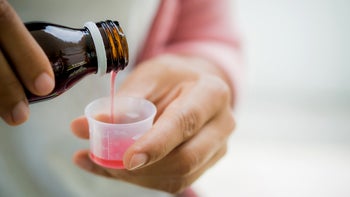
The 5 Best Medications for Seasickness: Dimenhydrinate, Scopolamine, and More
Key takeaways:
Scopolamine (Transderm Scop) and promethazine are prescription-only seasickness medications. Dimenhydrinate (Dramamine), diphenhydramine (Benadryl), and meclizine (Bonine, Dramamine Less Drowsy) are over-the-counter options.
Medications for seasickness work best when you take them in advance, not after you’re feeling unwell. You should take dimenhydrinate 30 to 60 minutes before you set sail.
The best seasickness medication for you will depend on factors such as age, affordability, and convenience.
Access savings on related medications
Table of contents

Feeling queasy on a cruise makes it tough to enjoy your vacation. Thankfully, there are many seasickness medications available to help prevent and manage your symptoms. Since motion sickness and seasickness tend to go hand in hand, the medications for managing them are similar.
Your healthcare professional (HCP) can help you choose the best seasickness medication for you. This will help you prepare before embarking on the seas.
What are the best medications to prevent and treat seasickness?
A variety of prescription and over-the-counter (OTC) medications are available for seasickness.
Save on the top 10 pet medications
Save big on common pet medications like Fluoxetine and Levetiracetam at your local pharmacy.

GoodRx is NOT insurance. GoodRx Health information and resources are reviewed by our editorial staff with medical and healthcare policy and pricing experience. See our editorial policy for more detail. We also provide access to services offered by GoodRx and our partners when we think these services might be useful to our visitors. We may receive compensation when a user decides to leverage these services, but making them available does not influence the medical content our editorial staff provides.
If you frequently experience seasickness, it’s best to take your medication before sailing to prevent symptoms, such as nausea and vomiting. Seasickness medications work best when taken ahead of time. But they still may offer some benefit if you take them after symptoms develop.
Even if you don’t typically experience seasickness, it’s a good idea to have medications on hand in case you hit rough seas. Ships typically have seasickness pills on board in case you forget to bring your own.
We’ll detail what to know about five standard seasickness medications.
1. Scopolamine
Scopolamine (Transderm Scop) is a first-choice medication for preventing seasickness in adults. One reason for this is that it’s less likely to make you sleepy than other seasickness medications. Scopolamine prevents nausea by blocking a chemical messenger in your body called acetylcholine.
Scopolamine is a prescription-only patch that you place behind your ear. One patch lasts for about 72 hours (3 days), making it a convenient option for cruises and long fishing trips. After 3 days, remove the patch. If you still need relief, you can apply a new patch behind your other ear.
The most common scopolamine side effect is dry mouth, but it may also cause blurred vision, drowsiness, and dilated pupils. Keep in mind that the longer you use scopolamine patches, the greater chance you have of experiencing side effects after stopping it. Contact your HCP if you experience symptoms such as dizziness, nausea, or sweating after removing your scopolamine patch.
Good to know: Kids younger than 12 years old should avoid using scopolamine patches. They’re more likely to experience mental health side effects from the medication, such as hallucinations.
2. Dimenhydrinate
Dimenhydrinate (Dramamine) is a popular OTC option for preventing and treating seasickness in adults and kids ages 2 years and older. Research suggests this antihistamine is just as effective as scopolamine.
Dimenhydrinate comes as 25 mg chewable tablets and 50 mg standard tablets. A typical adult dosage of dimenhydrinate is 1 to 2 tablets (50 mg to 100 mg) by mouth every 4 to 6 hours as needed. Do not take more than 8 tablets in 24 hours, though. Kids 12 years and older can take the adult dose, but the best dose for younger kids will depend on their age.
Drowsiness, constipation, and dry mouth are a few examples of common dimenhydrinate side effects. These side effects are temporary and should go away after you stop taking it. Dimenhydrinate also contains a substance called xanthine to make it less sleep inducing than diphenhydramine — the next seasickness medication we’ll talk about.
3. Diphenhydramine
Diphenhydramine (Benadryl) is a common part of many first aid kits. It can help manage allergic reactions. But it’s also an effective off-label option for preventing and treating seasickness in adults and kids.
Like dimenhydrinate, diphenhydramine is an OTC antihistamine. It comes as tablets, capsules, and chewable tablets. It’s also available as an oral liquid. The recommended diphenhydramine dosage for adults and kids ages 12 and older is 1 to 2 tablets (25 mg to 50 mg) by mouth every 4 to 6 hours as needed. Don’t take more than 6 doses in 24 hours.
The diphenhydramine dosage for younger kids is based on age. The product label provides information for kids ages 6 years and older, but diphenhydramine can be given to kids as young as 2 years old. It’s important to get a dosing recommendation from your child’s HCP if they are under 6 years old.
Good to know: Diphenhydramine shares similar side effects as dimenhydrinate, such as drowsiness and dry mouth. But it can make some kids feel hyper and agitated. If diphenhydramine has this effect on your child, avoid giving doses close to bedtime.
4. Meclizine
Meclizine (Bonine, Dramamine Less Drowsy) is another OTC antihistamine. It prevents and treats seasickness in adults and kids ages 12 years and older. Studies suggest meclizine isn’t as effective as scopolamine or dimenhydrinate, but it shouldn’t make you feel as sleepy as dimenhydrinate or diphenhydramine.
Meclizine comes as tablets and chewable tablets. The typical meclizine dosage is 1 to 2 tablets (25 mg to 50 mg) by mouth once daily. Other tablet strengths are also available.
If meclizine makes you feel drowsy, consider taking your daily dose at bedtime. Besides drowsiness, other common meclizine side effects include headache, dizziness, and dry mouth.
5. Promethazine
Promethazine is a prescription-only antihistamine. It prevents and treats seasickness in adults and kids ages 2 years and older. Promethazine can also manage nausea and vomiting if you start experiencing seasickness symptoms.
Promethazine comes as a tablet, a rectal suppository, and an oral liquid. Another option is an injection given by your HCP, but this form isn’t usually recommended for seasickness. A standard adult promethazine dosage is 25 mg by mouth twice daily. Kids ages 2 years and older can take 12.5 mg to 25 mg of promethazine twice daily.
Common promethazine side effects include drowsiness, dizziness, and dry mouth. Promethazine can cause more serious side effects, but these are rare. Seizures and movement problems are a couple of examples. Contact your HCP if you experience any serious side effects.
Good to know: Promethazine can rarely cause breathing problems in kids under 2 years old. That’s why it shouldn’t be used in this age group. Promethazine even carries a boxed warning — the FDA’s most serious medication warning — for this reason.
When should you take seasickness medications?
It’s best to take seasickness medications in advance to prevent symptoms. But the optimal timing depends on the medication — some medications work faster than others. This chart has advice on each medication.
Medication | When to take it before sailing |
Scopolamine | 4 hours |
Dimenhydrinate | 30-60 minutes |
Diphenhydramine | 30-60 minutes |
Meclizine | 60 minutes |
Promethazine | 30-60 minutes |
If you’re feeling normal, it’s easy to forget to take your preventive dose. If you’re prone to seasickness, it’s a good idea to set a reminder to take your seasickness medication before you set sail.
Also, if you have a full schedule on a cruise, carry your medication with you for convenience. That way, you won’t have to return to your cabin for your next dose.
When the ship is docked at a port, you’ll likely be able to take a break from seasickness pills.
Tips for preventing and treating seasickness without medication
Besides medication, there are other ways to prevent and treat seasickness while sailing, including:
Distracting yourself with music or breathing exercises
Lying down and resting
Drinking water to stay hydrated
Eating small, frequent meals
Getting fresh air
Limiting drinks with alcohol or caffeine
Trying ginger candy to settle your stomach
Wearing an acupressure wristband to relieve symptoms
Does chewing gum help with seasickness?
Potentially. Some studies suggest that chewing gum may help lessen seasickness symptoms. There are different theories about why this is, but none of them has been proven.
Can you combine different seasickness medications together?
It’s best to avoid combining different seasickness medications. This increases the risk of side effects.
For instance, if you take scopolamine and dimenhydrinate together, you may experience more drowsiness and dry mouth than usual. And medications such as dimenhydrinate and diphenhydramine are in the same class. Combining them could worsen spells of drowsiness, dizziness, and dry mouth.
Instead, it’s safer to combine your seasickness pills or patches with non-medication options, such as an acupressure wristband.
What factors should be considered when choosing a seasickness medication?
Your age should be one part of your checklist. All seasickness medications should be used cautiously by people ages 65 and older. This is because older adults are more sensitive to common side effects, such as drowsiness, dizziness, and dry mouth. Different medications also have different minimum age requirements.
How fast the medications work can also come into play. Scopolamine patches last longer than the oral seasickness pills. But medications like dimenhydrinate start working faster.
Affordability is another factor to consider. The seasickness medications mentioned above are all available as generic products, and GoodRx discounts are available when they’re filled by the pharmacy. This helps lower costs. GoodRx discounts can even cover OTC medications if your HCP writes a prescription for them. But some medications will be costlier than others, so your pharmacist can help you determine which medications fit into your budget.
The bottom line
There are a variety of seasickness medications available to fit your needs. Dimenhydrinate (Dramamine), diphenhydramine (Benadryl), and meclizine (Bonine, Dramamine Less Drowsy) are a few over-the-counter examples. Scopolamine (Transderm Scop) and promethazine are prescription-only options. The best seasickness medication for you will likely depend on age, affordability, and convenience.
Why trust our experts?



References
Brainard, A., et al. (2014). Prevention and treatment of motion sickness. American Family Physician.
Brown, A. (2023). Motion sickness. CDC Yellow Book 2024.
Bryant Ranch Prepack. (2024). Scopolamine transdermal system- scopolamine transdermal system patch, extended release [package insert].
Cardinal Health. (2024). Dimenhydrinate tablet [package insert]. DailyMed.
Guideline Central. (2023). Beers criteria for potentially inappropriate medication use in older adults.
Johnson & Johnson Consumer. (2024). Children’s Benadryl chewables- diphenhydramine hydrochloride tablet, chewable [package insert]. DailyMed.
Kaufeld, M., et al. (2022). Chewing gum reduces visually induced motion sickness. Experimental Brain Research.
Lin, C. H., et al. (2014). Delirium after transdermal scopolamine patch in two children. The Journal of Neuropsychiatry and Clinical Neurosciences.
LiverTox: Clinical and Research Information on Drug-Induced Liver Injury. (2017). Dimenhydrinate. National Institute of Diabetes and Digestive and Kidney Diseases.
Patel, P. N., et al. (2011). Meclizine: Safety and efficacy in the treatment and prevention of motion sickness. Clinical Medicine Insights: Therapeutics.
PD-Rx Pharmaceuticals. (2024). Meclizine 25- meclizine hydrochloride tablet, chewable [package insert]. DailyMed.
Sicari, V., et al. (2023). Diphenhydramine. StatPearls.
Southard, B. T., et al. (2024). Promethazine. StatPearls.
Sutton, M., et al. (2012). Treatment of motion sickness. American Family Physician.
Takov, V., et al. (2023). Motion sickness. StatPearls.















